Avalanche Blockchain - Crypto Academy /S5W8 - Homework Post for Pelon53
Hello friends, This is the last week for the prestigious Season 5 of the SteemitCryptoacademy lessons. It is my pleasure to welcome you to my blog as I participate in this week's lessons presented by Prof @pelon53 on Avalanche Blockchain. Let's get started friends...
Explain in detail X-Chain, C-Chain, and P-Chain.
In solving some of the outstanding and pending blockchain issues observed since the emergence of cryptocurrency and blockchain technology, the Avalanche was created to handle particularly the scalability feature which has since been the Trilemma in the space. In doing so, it came up with three (3) Intereperoable blockchain which handles the Decentralization, Scalability as well as Security of the entire ecosystem; the X-Chain, C-Chain, and the P-Chain.
The Exchange Chain (X-Chain)
Just as the name implies, the X-Chain is a platform that enables decentralization activities in the system where we have the creation and Exchanges of the AVAX tokens and some other digital assets. Just like a typical blockchain with rules which govern its protocol, so is the X-Chain whose assets have modifiable rules that govern the behavior of the protocols.
The AVAX is the dominant token used in the Transaction fee payments and other rewards therein in the protocol with consensus mechanism directly on the Avalanche Consensus Protocol but this does not make the JOE and PNG tokens far from its use in the platform. This dominating scenario of the AVAX makes t simple that even when one is transacting the JOE or PNG tokens, fees are likely settled in the AVAX.
Having known the EVM functionality with its compatibility with the Avalanche, the Avalanche Virtual Machine (AVM) has the same use which the X-Chain derives its use case. With this, the X-Chain API can now allow clients to create and trade digital assets using its system.
The Contract Chain (C-Chain)
This is the mainstay of the Avalanche protocol which is Smart contracts. With the C-Chain which makes available the creation of smart contracts to clients, developers can now create their own dApps by leveraging on there systems' scalability and security indices. This makes it much easier for wider adoption given that smart contracts can be built on the system as well relative to its compatibility with the EVM (Ethereum Virtual Machine). This invariably means that other Ethereum dApps can be deployed on the Avalanche. Anyone who understands the position of the Ethereum protocol vis-a-vis its versatile role in smart contracts attainment would surely note that this is a great fit for avalanche protocol.
This uses the Avalanche consensus protocol known as the SNOWMAN which is a modified version. Its compatibility gives it an upper hand relative to the EVM as it does not only offers Network speed during transaction but also Cheap Transaction.
The Platform Chain (P-Chain)
This is a system that takes into cognizance the activities of validators in the protocol. Validators are organized in subnets and in such a manner that there is the creation of new subnets. A subnet here simply means a collection of validators who provide consensus to the blockchain. Subnets are observed to validate but single blockchains as well as multiple blockchains with the use of the SNOWMAN consensus protocol.
The P-Chain API, allows clients to create subnets in its system, add validators to these created Subnets, as well as create blockchains. Therefore the P-Chain is likened to b a Metadata platform that oversees the pool of validators in the system, maintains its active subnets as well as new subnet creations.
Explore the Avax Network platform. Screenshots required.
From the landing page, this is what we have an interface displaying how Blazingly Fast is the Protocol, Low-cost feature as well Eco-friendly.
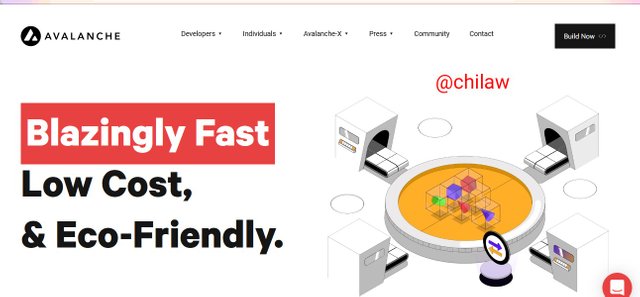
When we scroll down, this also comes with some sterling comparison between Avalanche and other Blockchain ecosystems. This can be well captured given to its exclusive advantages highlighted.
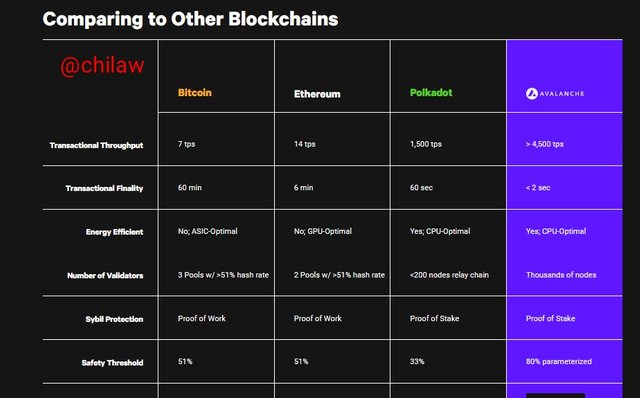
In exploring more on the AVAX NETWORK, we will be clicking on the different headings/options on the top screen for its individual features.
The Developers
This consist of two subheadings;
- the Validators and
- the Start Building options
The Validators option gives us the Validators Stats at the time of exploring the network. We have a total Stake (AVAX) of 230,834,092.61, Validation Stakes of 202,383,243, and Delegated Stake of 28,450,849.
There's a staking ratio of 58.22%, a Staking reward of 9.79%, Total Validators of 1,193 with Total Delegations of 15,888.
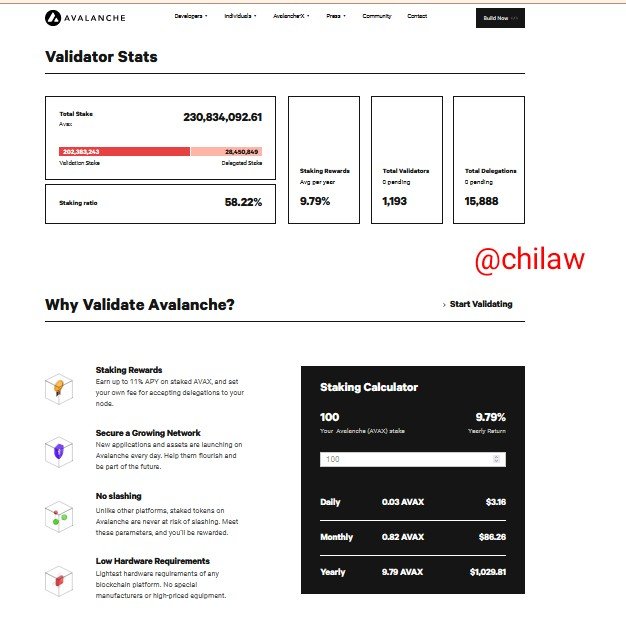
There are also details stating the importance of being a Validator in Avalanche which include; UpTo 11% APY, High Network Security, Non-Existence of slashing Tokens as well as Low Hardware Requirement.
For the Start Building options, we have a display of quick starts on Network which include the Launch your Ethereum dApp, Run a Validator, Mint a Token, Integrate and Exchange, and also the Developer Documentation.
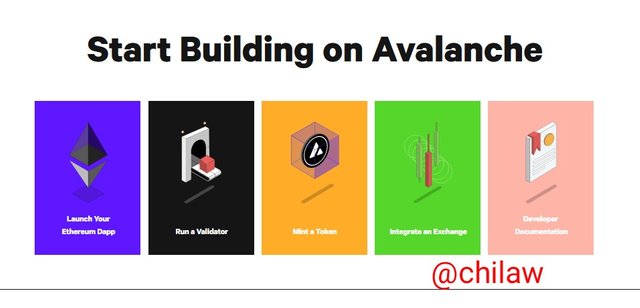
The Individuals
Under this category, we have the following information;
- Roadmap: Gives a clear-cut journey timeline of the Avalanche network so far. This comprises a quarterly time measurement of platform enhancements, milestones, and projects in the ecosystem.
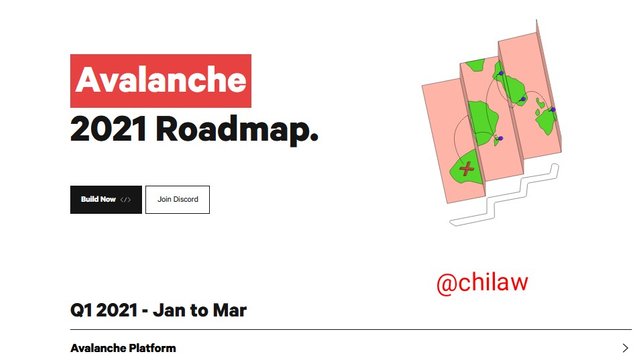
- Solutions: this displays the different solutions obtainable in the avalanche network. We have Decentralized Finance (DeFi), NFTs, Institutions, Enterprise, and Government Solutions all powered up here.
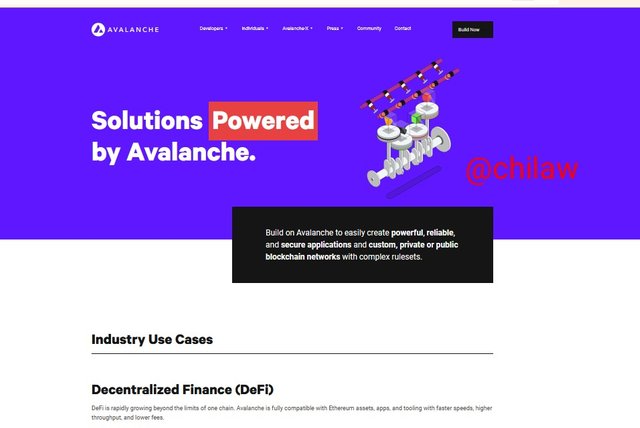
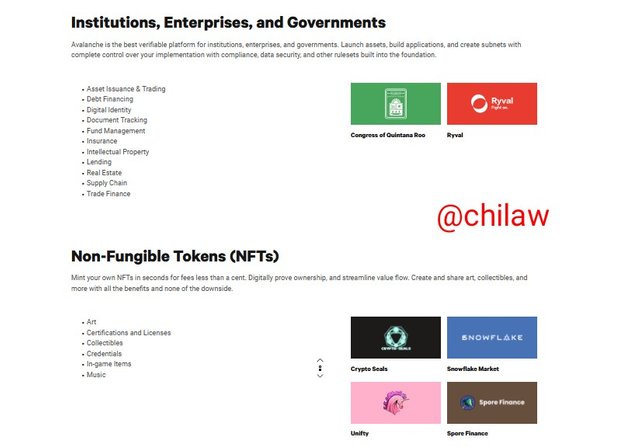
- Ecosystem: This is a make that cut across the entirety of the avalanche network. We have the DeFi, Digital Securities, Exchange, Wallet, Wealth management, etc. When we scroll down we cal as well see the different logos that represent different brands.
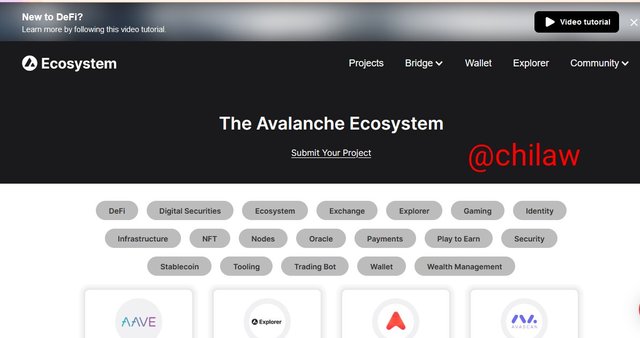
Others under the individual category include the;
- Avalanche wallet:
- Avalanche Explorer
- Avalanche Bridge
The Press Feature
We have the Press inquires and the Press kit & Media Assets. Clicking on the Press inquires takes you directly to the mailing system which hence enables you to make your inquires on the Avalanche network.
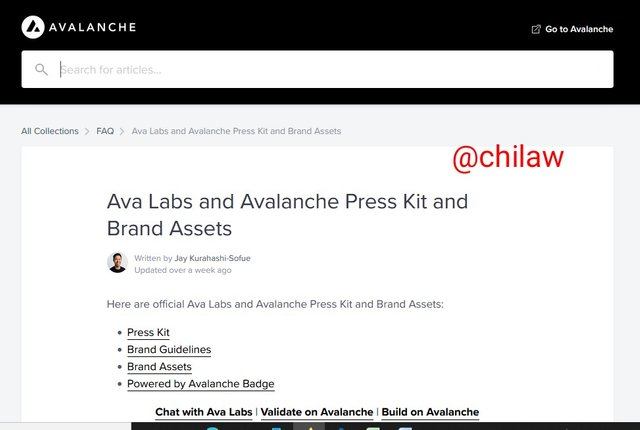
On the other hand, the Press kit & Media Assets bring out a search box that helps for more information.
Show the last contract verified in the C-Chain network and show the Smart Contract that was generated at that address. Screenshots required
In getting the last contract using the C-Chain Network, we will have to log in using the snowtrace.io link.

Then from the available option on the top screen, click on the Blockchain option and then on Verified Contracts.
This will bring out an interface that displays all available contracts but for the purpose of this post, we are to show details for the last verified contracts. Therefore, click on the last information there with the contact address.


Contract address: 0xdbd4143e6cba725D60d6540fa3E6e9d2c522c089
Contact Name: Multicall
For more information on the smart contract that generated Transaction details, click on the Trn Harsh link to generate these details.


Explore the last block generated in the C-Chain network. Screenshots required.
We will have to apply the same process by logging into the snowtrace.io link. From the landing page, click on the Blockchain option from the Top screen. Then click on the View Blocks from the dropdown menu.

This would bring out the list of blocks in view but or emphasis is on the last block. From the image, we can see that the last block was created 6 seconds ago as at the time of the report.
Block ID: 9161642
Gas used: 791,134
Burned (AVAX): 0.04664 AVAX
Block #0x14261c808fc43deb067d237d86340199c034267e551943420869237e0fea3e21


Explain in detail the Avalanche Consensus Protocol and Snowman Consensus Protocol
The Avalanche Consensus Protocol
This consensus protocol derives its own explanation from the workability of already existing consensus mechanisms like the proof of Work (PoW), Proof of Stake (PoS), Delegated Proof of Stake (DPoS). All these consensus mechanisms are observed to need a LEADER to reach a consensus mechanism whereas this is not needed for the Avalanche Consensus Mechanism. This means that there is no singular actor that leads transactions for other validators to follow suit in the system rather all or any validator in the system can start up the process of consensus mechanism.
All available nodes present in the system are used in the process of validating transactions in the protocol via the use of a Directed Acyclic Graph (DAG). The DAG allows that network to processes transaction in a parallel manner by randomly picking validators to validate transactions in a different and repeated random sampling. After this is ascertained and valid we have what we know as the Vertices or parented transactions where they are stored which replaces the block concept of other known consensus mechanisms.
The Snowman Consensus Protocol
This which is also available in the Avalanche Ecosystem is built in the avalanche consensus mechanism but at this time transactions are observed and processed LINEARLY. And another important note in this Consensus mechanism is that processed and validated transactions are stored in Blocks this time unlike the Vertices observed in the Avalanche Consensus Protocol. In the execution of smart contracts, this type of mechanism is most important in handling orders Linearly.
Conclusion
The Avalanche Blockchain who emergence was to solve issues of the existing blockchain limitation or what we may term the Trilemma was indeed a good introduction with the presence of the different subnets (blockchains) which it rides on to main Decentralization, Security as well as Scalability. These blockchains which include the X-Chain, C-Chain, and X-Chain are all interoperable and also ride in the Avalanche ecosystem.
It is observed to come with a transaction Throughput of over 4500TPS which is greater than all existing blockchain systems and Transactional finality of 2-seconds which is also the least in the queue. It has less energy requirement during the validation process, maintains thousands of validators (Nodes) in its system for more decentralization of process, and more importantly LESS TRANSACTION fees which makes it more attractive for wider adoption.
Thank you Professor @pelon53 for your lessons, I Look forward to seeing you in the next season.